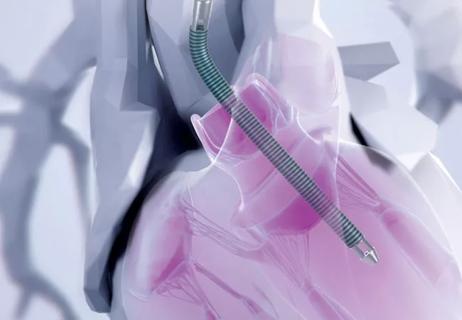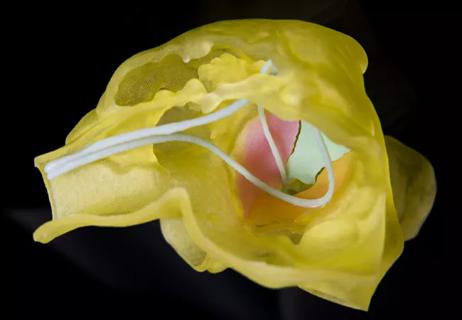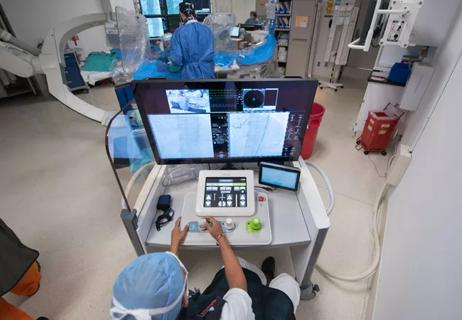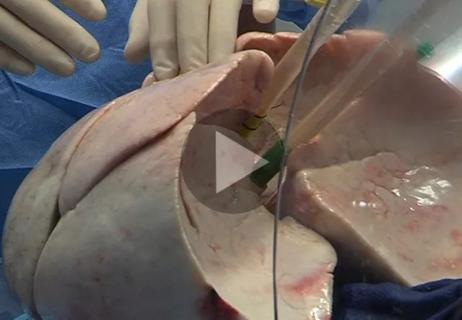Q&A with an electrophysiologist at the forefront of virtual visits, wearables and more
Cleveland Clinic electrophysiologist Khaldoun Tarakji, MD, MPH, has been a pioneer in the use of digital technology in cardiovascular medicine. He was an early adopter of virtual visits and has published several studies on the clinical use of wearable and smartphone-based technologies for remote heart rhythm and implantable device monitoring. To find out where this field is headed and explore its merits and potential downsides, Cleveland Clinic Cardiovascular Medicine Chair Steven Nissen, MD, recently sat down with Dr. Tarakji for a Q&A. An edited transcript follows.
Advertisement
Cleveland Clinic is a non-profit academic medical center. Advertising on our site helps support our mission. We do not endorse non-Cleveland Clinic products or services. Policy
Dr. Nissen: How did you get interested in this area?
Dr. Tarakji: I’m an electrophysiologist, so a major part of my work is arrhythmias and detecting rhythm problems. One of the major obstacles is trying to catch an arrhythmia when it’s actually happening. That usually involves ordering different types of monitors, sometimes for up to 30 days, and a lot of expense. And all too often, Murphy’s law comes into play and no arrhythmia happens during the monitoring period.
Dr. Nissen: Yes, that’s certainly happened in my practice.
Dr. Tarakji: So these new products have come along that offer, for the first time, the opportunity for patients to record their rhythm strip using their smartphone or other smart device and then see what’s being recorded. For the patient, that’s a far cry from some monitoring machine that’s making a mysterious noise and sending a transmission. These products are sometimes marketed to consumers directly, and patients are coming to their physicians and showing us these products. So the roles have shifted, in that patients are more in the driver’s seat and we physicians are sometimes on the receiving end and no longer the gatekeepers of these monitors.
When I first encountered these products, after the initial “wow” reaction, I wondered: How can I use this? Can my patients use it? Let me test this. Let me see if it actually helps our workflow.
Dr. Nissen: So we have a device that can record the heart rhythm. And someone can buy this as a sort of accessory to their smartphone. Am I understanding correctly? And how much does it cost?
Advertisement
Dr. Tarakji: That’s absolutely correct. As far as cost, these accessories are quite inexpensive relative to other medical expenses. Almost anybody can afford them. And no prescription is needed. Consumers can just go online and buy one themselves.
Dr. Nissen: Have you used these devices in people who have had symptoms to detect when they’re having arrhythmia?
Dr. Tarakji: Sure. And for us, the most important step before adopting any new technology into our daily practice is to determine up front whether a particular device really achieves what it’s supposed to do. Let me share an example. A lot of our patients have atrial fibrillation, and one of the treatment strategies is to do an ablation procedure. Traditionally, the way we monitored patients after an ablation was via transtelephonic monitor — a machine that gets hooked up to the patient and sends a transmission by telephone landline. It makes a funny noise, and this is how we get the transmission. But today, of course, many patients don’t have landlines.
So about four years ago, we conducted the iTransmit study [Heart Rhythm. 2015;12:554-559], where we provided a smartphone accessory to a cohort of 60 patients who were undergoing ablation for atrial fibrillation and who owned a smartphone. The accessory allowed the user to record their heart rhythm strip. Patients were asked to record their rhythm using both the smartphone accessory and transtelephonic monitoring simultaneously whenever they had symptoms or at least once a week. A blinded physician compared the two sets of recordings for arrhythmias. Lo and behold, the smartphone accessory was found to do an excellent job. It achieved the task with excellent sensitivity and specificity.
Advertisement
Dr. Nissen: The same diagnosis?
Dr. Tarakji: The same diagnosis when the blinded electrophysiologist reviewed both. The real eye-opener was that this was four years ago in patients with an average age of 65. So these technologies are being adopted by patients of all ages. And in a survey of study participants, the vast majority said the accessory was very easy to use. They liked it. They said it got them engaged. Patients sometimes tell me, “I can show off with this in front of my grandkids.”
Dr. Nissen: So it empowers them, doesn’t it? They’re no longer a passive participant in their health but an active participant.
Dr. Tarakji: Exactly. They become true partners in their care.
But of course there’s a flip side, and we’ve got to do a reality check and talk about both the good and the difficult with these devices. For instance, because the transmissions were initially sent by email (and still are in some settings), these accessories can all of a sudden result in a flood of emails from patients. And the concerns go beyond just workload to include potential dangers too, such as receiving transmissions from people who aren’t even your patients. For example, in the study I mentioned, one of the enrollees was using his wife’s phone for transmissions. So I was getting transmissions labeled with the email of the spouse and not the patient himself.
Dr. Nissen: Everything that can go wrong will go wrong.
Dr. Tarakji: In some ways. But that’s the virtue of doing these initial studies because they allow you to identify difficulties and challenges early on, many of which are hard to anticipate. Here’s another example: To obtain a good recording, the patient needs to hold still for a fair bit of time Otherwise, the recording will be noisy. You have less control over that than you do with a trained technician doing a 12-lead ECG lead.
Advertisement
Dr. Nissen: Do patients still have to email the recording, or has a better way been developed?
Dr. Tarakji: We actually have a platform now that liberates patients from needing to email me directly. If patients sign up for this service, any time they record, as long as they have Wi-Fi or other access to the internet, their recording will automatically be transmitted to the cloud.
For me as a physician, I don’t need those emails back and forth. I can just view a patient’s recordings anytime, anywhere, once I log on to the platform.
Dr. Nissen: Can you share another example of how evolving digital technology is making patient care easier or better?
Dr. Tarakji: Sure. Let’s take virtual visits, which are especially well suited to my field of electrophysiology, particularly for our established patients who are coming from out of state and want to do follow-up visits. Instead of an in-person visit to the clinic, a virtual visit allows the patient and me to have a Skype-like video conference, with me sitting in the office next to my computer and with the patient using their smartphone or smart tablet or a desktop computer. I can see them, and they can see me.
This might sound like just a glorified phone conversation, but it’s more than that when you equip it with these additional devices and accessories we’ve been discussing. Now, not only do I have this communication between me and the patient but I can access the recordings they’ve done over the past six months. I would argue that a virtual visit of this type, if I have data from recordings they’ve done over several months, is even more valuable and meaningful than an in-person visit with a single 12-lead ECG. So you need to be creative in how you do it, and this is where it becomes specific to your specialty or subspecialty.
Advertisement
Dr. Nissen: Have you done a lot of virtual visits to date?
Dr. Tarakji: For my out-of-state patients, yes. These patients find virtual visits very valuable for their regular follow-up, and they continue to use them. I can interview patients during these visits and review their data, but of course I can’t put a stethoscope on their chest — at least not yet. But the technologies have evolved at such an unbelievable pace that remote listening to heart sounds may be a possibility before too long.
But that’s why I say we’re probably at some advantage in electrophysiology. Our patients are relatively established — they’ve already had their echocardiograms and their workups done. They’re coming for one specific problem, their arrhythmia, which can be monitored from a distance.
Dr. Nissen: You’ve done some work involving remote checking of implantable cardiac devices. Can you explain?
Dr. Tarakji: The evolution of technology around the remote checking of pacemakers and defibrillators is one of the most exciting stories in this area. We electrophysiologists routinely check these devices in patients — the battery life, thresholds, undetected arrhythmias, lead functionality, even the patient’s activity level. There’s a lot of data to be gained.
Patients used to take a day off from work to come in so we could interrogate the device. That evolved over time, and for the last couple of decades we’ve had the concept of a remote device check. It started with transtelephonic monitoring over a landline, where the patient would put a wand over their implanted device and then transmit the data over. The wand was connected a box next to a phone, typically in their bedroom. They’d have to phone in to transmit their data.
But that has evolved and now it’s happening through a cellular network, with the box in the bedroom communicating with the pacemaker or defibrillator. So it’s done wirelessly and with less effort, but you’re still relying on that box in the bedroom. So if the patient is not in proximity to that box — if they’re traveling, for instance — there’s no transmission. This has probably contributed to the suboptimal compliance with regular monitoring, which undercuts the ability of remote monitoring to improve outcomes and healthcare costs.
But the newest development is that the patient’s pacemaker will talk directly to their smartphone through Bluetooth signal, and their smartphone will act as a vehicle to transmit the data. So patients are no longer at the mercy of being near that box in the bedroom. They can travel pretty much anywhere in the world with Wi-Fi internet access, and as long as they’re in close proximity to their phone, they can transmit their device recordings. And for the first time, patients will have visibility to some basic information about their implanted device through the dedicated app on their smart device.
Dr. Nissen: What about potential downsides?
Dr. Tarakji: This type of development is exciting, but there are certainly challenges out there. In real-life clinical practice, there’s still a big gap between all the noise around digital health and our daily work. We’re trying to bridge that gap.
There’s also the risk that wearable devices can alarm healthy people for no good or reliable reason. If we ultimately reach a point where some of these devices have the ability to reliably screen the population, that will be great. Unfortunately, for now we have a gap in our knowledge about what device readings mean for healthy people. For example, what do we do about a few seconds of atrial fibrillation in someone who’s completely asymptomatic and previously healthy? What do we do with that information?
Dr. Nissen: We have to study it, don’t we?
Dr. Tarakji: Exactly, and some studies are underway. Meanwhile, we have ample opportunity to improve our workflow for patients currently using these devices.
Dr. Nissen: And we’ll have to separate the wheat from the chaff, as I imagine some of these innovations seem great in theory but may end up doing more harm than good when actually implemented.
Dr. Tarakji: That’s right, and it all starts from clear needs assessment, moving to validation and creating a proper workflow to adopt it. It’s a journey, but a fun one.
Dr. Nissen: But it also suggests we’re in a dangerous time in some ways, because the regulatory authorities haven’t quite caught up with this. Right now, if a company wants to get a medical device approved for use, they have to go through a fairly rigorous process with the FDA. But if their product is a medical app, it’s not so clear what happens.
Dr. Tarakji: Correct, even if it’s a wearable device. It’s almost like the process is reversed: Approval for marketing is often preceding our ability as clinicians to independently test and validate the device to see if it really works as designed and also if our patients are actually able to use it. The majority of consumers stop using wearable devices after six months. So there are issues of compliance as well as questions around whether clinicians can adapt and keep up with the newly created workload. A wearable device should not equate to a wearable physician, and digital technology should be an asset — not an extra burden — for physicians. If we have these devices and we just collect the data without knowing what to do with it, that’s a big and extremely important problem.
But it’s clear that these developments are the future. We just need to keep an open mind and focus on sharing ways that we can manage the data from these devices and accessories so that both patients and their physicians are well served.
This post was derived from an episode of Cleveland Clinic’s “Cardiac Consult” podcast for healthcare professionals.
Photo credit: © Russell Lee
Advertisement

Patient-patient network analysis proves to be fast and clinically intuitive

How we’re using a new multidisciplinary approach to broaden the benefits of ablation

Models developed with promising accuracy and generalizability to clinical practice

Illustrated case series profiles a valuable tool for a rare and complex entity

A minimally invasive, single-incision approach to two coexisting problems

A long-overdue technology is poised to reshape practice

A short video portrait and overview of our experience to date

A glimpse into our centralized monitoring strategy and more